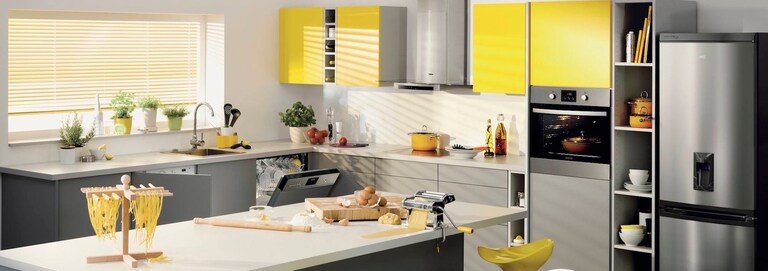
FIND YOUR PERFECT COOKER HOOD
Choosing the right cooker hood? Easy.
From the food you love to eat to the size of your kitchen, there's a lot to think about. Our handy buying guide will help you make a great decision.
FOOD
If you fry, grill or cook with steam you’ll need a more powerful hood. Strong-smelling, spicy and fishy food will also require greater suction. Not only because of the smell but because grease can build up in hard to reach spots and damage your beautifully painted walls.
Power
If you often cook strong-smelling foods or have a large kitchen you'll need a more powerful cooker hood. Here's how to work out your minimum extraction rate:
1. Measure: your kitchen's length, width & height.
2. Multiply: length x width x height = cubic capacity.
3. Multiply: the cubic capacity x 12 = minimum extraction rate.
Easy.
This will give you the minimum extraction rate for 12 changes of air per hour. Between 8 and 12 changes is recommended.
Air circulation
Got an external vent?
Extraction hoods remove the stale air from your kitchen through a duct, so will need access to an outside vent. The further you position it away from the vent, the more powerful a motor you’ll need.
Recirculation hoods don't need access to the great outdoors. Air is sucked through a grease filter and then a charcoal filter to purify the air before returning it, nice and fresh, to your kitchen.
#EASYTIP: turn on your hood before you start cooking to get the circulation or extraction going.
TYPE OF COOKER HOOD
There are plenty of styles to choose from. Allow us to introduce you to the:
Wall decorative hood – whether flat or a chimney style, these stand-out hoods come in a variety of sizes to suit your kitchen.
Island decorative hood – a match made in heaven for social kitchens with a cooking island. These chimney hoods are suspended from the ceiling, not wall-mounted.
Built-in – to blend in with the style of your kitchen, these can be hidden away when you're not cooking.
Built-under - Save some space and put your hood under the cabinet above your hob. It’s completely hidden until it’s time to cook. Leave 40cm – 75cm between your hob and hood depending on the model you go for. Play it safe and check your space before you buy!
NOISE
For a quieter kitchen, choose a hood with a lower decibel (dB) rating. Our hoods range between 50 and 65dB. For comparison, normal kitchen chit chat measures 62dB and a kettle boils at 42dB. For extractor hoods, the duct design can make all the difference. So for a quieter hood, you should think about the bends, length, cross-section and material of the ducting. But remember, minimum extraction rate is more important than volume. A quiet hood without enough power is as good as a quiet vacuum that doesn’t suck up dust.
Cleaning
Some filters need to be replaced, others can be washed and re-used. Grease filters capture grease and food particles and should be cleaned or replaced every 15 - 100 hours depending on the type. For recirculation hoods, active carbon filters remove odours and should be cleaned or replaced approximately every 4 months.
Reusable filters – Washable charcoal, metal mesh and stainless steel filters can be washed by hand or put in the dishwasher on a 65°C intensive programme. Easy. Do this every 2-3 months up to 5-6 times.
Replaceable filters – Disposable charcoal and paper filters should be replaced approximately every 4 months.
READY TO CHOOSE YOUR COOKER HOOD?
Explore our range now. From traditional chimney hoods to sleek, stylish modern designs with clever features like self-cleaning.


